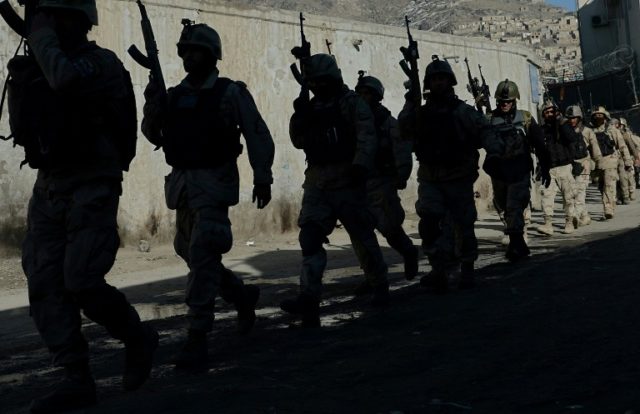Confrontations between Taliban and U.S.-backed Afghan forces resumed again in the provincial capital of Farah on Thursday less than a day after the American military and Kabul asserted that the Afghan government remains in control of the urban center, located close to the Iranian border.
Gen. John Nicholson, the top commander of U.S. and NATO troops in Afghanistan, has accused state sponsor of terrorism Iran of lending support to the Taliban, which some local officials and analysts have suggested is what is taking place in Farah city, the capital of the western Afghan province of the same name.
An estimated 2,000 Taliban jihadists took control of the city for about a day until they were pushed out by members of U.S. air power-backed Afghan National Defense and Security Forces (ANDSF) during the day Wednesday.
On Thursday, TOLO News reported that the jihadists maintained a presence in the city even after the U.S. military and Kabul proclaimed that the Afghan forces had cleared the provincial capital of the terrorists.
“Residents said the Taliban had been pushed back from the city, but they were in Shir Koh, Pesht Koh districts and Regi area of the city,” TOLO noted. “Salangi said security forces will continue their operations to destroy the insurgents in the province.”
According to Kabul, U.S.-backed ANDSF troops killed between 198 and 300 Taliban narco-terrorists as they repelled the jihadists’ attempt to seize the urban center.
Farah city is the second major urban center to briefly fall to the control of the Taliban since the U.S. removed the group from power in late 2001.
Local Afghan news outlets report that, by night time on Wednesday, the situation had changed in Farah city, with battles between the Taliban and the ANDSF breaking out again, less than a day after Kabul declared the city to be Taliban free.
Nevertheless, Martin O’Donnell, a spokesman for the U.S.-NATO Resolute Support (RS) mission, maintained on Wednesday night, “Farah remains under the Afghan government’s control,” TOLO pointed out.
This week, Afghanistan’s ministry of defense and U.S. Forces-Afghanistan (USFOR-A) did acknowledge that the hunt for the remnants of the Taliban jihadists who may have hidden in Farah was underway, with the American forces writing on Twitter: “Taliban fighters are on the run.”
By Thursday morning, Khaama Press (KP) had reported:
Clashes have once again erupted among the security forces and the Taliban insurgents in Farah city, the provincial capital of Farah province.
According to the eyewitnesses and the residents of the city, the clashes broke out late on Wednesday night in some key parts of the city … local residents are saying that the militants may have launched the latest attack from the residential areas close to the government compounds.
According to reports, the militants have attacked the intelligence compound, the police commandment, as well as the central prison.
TOLO News also reported that the Taliban launched its latest attack on Farah from within, after hiding in civilian houses, noting:
Officials confirmed three suicide bombers detonated explosives close to police headquarters and government buildings on Wednesday night.
Local officials confirmed early Thursday that clashes between government forces and Taliban insurgents have resumed in Farah city after insurgent’s attacked security forces on Wednesday night. The officials said Taliban insurgents are hiding in civilian houses.
On Tuesday, the New York Times (NYT) reported that local officials and Atiqullah Amarkhel, a retired Afghan Army general and military analyst in Kabul, believe state sponsor of terrorism Iran is helping the Taliban mount the attack to seize Farah city.
Iran vowed to retaliate against the United States over American President Donald Trump’s decision to withdraw from the controversial nuclear deal reached between Tehran and U.S.-led world powers in 2015.
In August 2017, President Trump unveiled his Afghanistan strategy, focused on ending the 17-year-old war by pressuring the Taliban to engage in peace negotiations with Kabul.
U.S. Secretary of Defense Jim Mattis and U.S. Special Inspector General for Afghanistan Reconstruction (SIGAR) John Sopko have argued that Trump’s strategy needs time to take effect.
The Afghan government conceded this week that seven urban centers, including Farah city, are facing “serious security threats” from the Taliban, but asserted that the Afghan troops are ready to defend the cities, TOLO News reports.
Since the U.S. military overthrew the Taliban regime in late 2001, the Taliban’s power and influence have been concentrated in rural areas.
Despite the nearly $70 billion in American taxpayer funds devoted to developing the Afghan security forces, the troops still suffer from capability gaps.
“The Taliban managed to leave the city without a single shot being fired, and the night was calm,” Abdullah Khan, a Farah city resident, told the New York Times, referring to the brief fall of the provincial capital to the terrorist group on Tuesday. “It shows the utmost incompetence of our forces. The Taliban were wandering the Farah city streets openly without fear as if they had lived there a long time, making jokes with their friends and telling citizens to stay calm and not worry.”

COMMENTS
Please let us know if you're having issues with commenting.